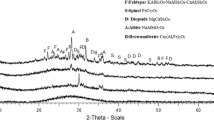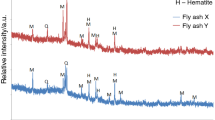Abstract
Scanning electron microscopy (SEM), energy-dispersive X-ray (EDX) spectroscopy and X-ray diffraction (XRD) analyses were used to characterise the microstructure and chemical composition of a glass and a glass-ceramic material obtained from incinerator filter fly ash. Although the as-quenched material (vitrified fly ash) was amorphous under the detection limits of XRD, a dispersion of droplets indicating glass-in-glass phase separation was observed. In the glass-ceramic material (crystallised vitrified fly ash), crystals belonging to the pyroxene group and spinels were identified. The microstructure of the glass-ceramic consisted of crystals embedded in an amorphous glassy phase. The crystalline phases contain a higher amount of metallic elements (e.g. Al, Cr, Fe, Ni and Zn and most probably also other heavy metals) than the residual glassy phase. A change of composition of the residual glass phase in the glass-ceramic product, in comparison with the parent glass, is considered to explain, in comparative terms, the higher toxic potential of the glass-ceramic over the glass. The present results demonstrate that for an accurate assessment of the correlation between toxicity, release of hazardous compounds and microstructure, high-resolution characterisation techniques must be employed. In this context, the effect of crystallisation on the chemical durability of the products remains as an important area for further research.
Similar content being viewed by others
References
O. Hjelmar, J. Hazardous Mat. 47 (1996) 345–368.
R. Derie, Waste Management 16 (1996) 711–716.
P. T. Williams, in “Waste Incineration and the Environment, Issues in Environmental Science and Technology,” edited by R. E. Hester and R. M. Harrison (Royal Society of Chemistry, 1994) pp. 27–52.
G. C. C. Yang and S.-Y. Chen, J. Hazardous Materials 39 (1994) 317–333.
M. T. Ali and W. F. Chang, ACI Materials Journal 91 (1994) 256–263.
O. Barin, Wiss. und Umwelt 3/4 (1991) 159–167.
R. Gutman, Glass Sci. Technol. 69 (1996) 285–299.
R. Mergler, Glas-Ingenieur 6 (1993) 83–88.
M. Krauß, Glastech. Ber. Glass Sci. Technol. 70 (1997) 375–381.
D. De labarre, Verre 3 (1997) 33–39.
D. F. Bickford and R. Schumacher, Ceram. Eng. Sci. Proc. 18 (1995) 1–10.
A. R. Boccaccini, M. Kopf and G. Ondracek, Z. Angewandt. Umweltforschung 7 (1994) 357–367.
A. R. Boccaccini, M. Kopf and W. Stumpfe, Ceram. Int. 21 (1995) 231–235.
A. R. Boccaccini, M. Petitmermet and E. Wintermantel, Ceram. Bull. 76 (11) (1997) 75–78.
P. Callejas, ObtenciÓn, Microestructura y Propiedades de MaterialesVitrocer ámicos con EfectoAventuvina, Ed. Univ. Autónoma de Madrid (1988) p. 46.
H. Rawson, “Properties and Applications of Glasses” (Elsevier, Amsterdam, 1980) p. 22.
L. A. Chick, R. O. Lokken and L. E. Thomas, Ceram. Bull. 62 (1983) 505–516.
J. MA. Ricon and R. Capel, Ceram. Int. 11 (1985) 97–102.
C. Hiriyama and F. E. Camp, Glass Technol. 10 (1969) 123–127.
J. MA. Rincon and H. Marquez, “Electron Microscopy,” Vol. 2 (EUREM 92, Granada, Spain, 1992) pp. 455–456.
A. Kipka, B. Luckscheiter and W. Lutze, Glastech. Ber. 66 (1993) 215–220.
J. MA. Rinc ÓN and M. Romero, Mat. de Construccion 46 (1996) 91–106.
L. Barbieri, T. Manfredini, I. Queralt, J. MA. Rincon and M. Romero, Glass Technol. 38 (1997) 165–170.
M. Pelino, C. Cantalini and J. MA. Rinc ÓN, J. Mater. Sci. 32 (1997) 4655–4660.
M. Romero and J. MA. Rinc ÓN J. Europ. Ceram. Soc. 18 (1998) 153–160.
M. Petitmermet, A. Favre, B. Shah, U. RÖsler, J. Mayer and E. Wintermantel, in “Monitoring and Verification of Bioremediation,” edited by R. E. Hinchee, G. S. Douglas and S. K. Ong (Battelle Press, Columbus, 1995) pp. 223–232.
T. R. Meadowcroft, Mat. Trans. JIM 37 (1996) 532–539.
S. D. Knowles and D. A. Brosnan, Canadian Ceramics Quarterly J. Canad. Ceram. Soc. 64 (1995) 231–234.
A. Dwivedi, Y. Berta and R. Speyer, J. Mater. Sci. 29 (1994) 2304–2308.
M. A. Audero, A. M. Bevilacqua, N. B. M. Bernasconi, D. O. Russo and M. E. Sterba, J. Nuc. Mat. 223 (1995) 151–156.
A. R. Boccaccini, J. Janczak, D. M. R. Taplin and M. KÖpf, Environmental Technology 17 (1996) 1193–1203.
L. Depmeier, U. Tomschi and G. Vetter, Müll und Abfall 9 (1997) 528–533.
Author information
Authors and Affiliations
Corresponding author
Rights and permissions
About this article
Cite this article
Rincó, J.M., Romero, M. & Boccaccini, A.R. Microstructural characterisation of a glass and a glass-ceramic obtained from municipal incinerator fly ash. Journal of Materials Science 34, 4413–4423 (1999). https://doi.org/10.1023/A:1004620818001
Issue Date:
DOI: https://doi.org/10.1023/A:1004620818001




